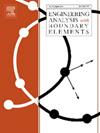Dual-branch neural operator for enhanced out-of-distribution generalization
IF 4.2
2区 工程技术
Q1 ENGINEERING, MULTIDISCIPLINARY
Engineering Analysis with Boundary Elements
Pub Date : 2025-02-01
DOI:10.1016/j.enganabound.2024.106082
引用次数: 0
Abstract
Neural operators, which learn mappings between function spaces, offer an efficient alternative for solving partial differential equations. However, their generalization to out-of-distribution (OOD) parameters often falls short, with accuracy rapidly decreasing outside the training domain. To tackle this issue, we propose a dual-branch neural operator architecture. In this setup, the in-distribution branch performs supervised learning from training data and transfers its learned knowledge to the OOD branch. The OOD branch then uses pseudo-solutions provided by the in-distribution branch to enhance the generalization capability of the neural operator. To ensure the OOD branch prioritizes more reliable information, we introduce a weighting method to control the contributions of different pseudo-solutions. Experimental results show that our method can improve OOD accuracy of neural operators while maintaining in-distribution prediction performance with a few or even no additional OOD observations. The code is publicly available at https://github.com/JcLimath/DB-NO.
增强分布外泛化的双分支神经算子
神经算子学习函数空间之间的映射,为求解偏微分方程提供了一种有效的替代方法。然而,它们对离分布(OOD)参数的泛化往往不足,在训练域之外精度迅速下降。为了解决这个问题,我们提出了一个双分支神经算子架构。在这种设置中,分布分支从训练数据中执行监督学习,并将其学习到的知识转移到OOD分支。OOD分支利用分布中分支提供的伪解来增强神经算子的泛化能力。为了保证OOD分支优先处理更可靠的信息,我们引入了一种加权方法来控制不同伪解的贡献。实验结果表明,该方法可以在少量甚至不需要额外OOD观测值的情况下,在保持分布内预测性能的同时,提高神经算子的OOD精度。该代码可在https://github.com/JcLimath/DB-NO上公开获得。
本文章由计算机程序翻译,如有差异,请以英文原文为准。
求助全文
约1分钟内获得全文
求助全文
来源期刊

Engineering Analysis with Boundary Elements
工程技术-工程:综合
CiteScore
5.50
自引率
18.20%
发文量
368
审稿时长
56 days
期刊介绍:
This journal is specifically dedicated to the dissemination of the latest developments of new engineering analysis techniques using boundary elements and other mesh reduction methods.
Boundary element (BEM) and mesh reduction methods (MRM) are very active areas of research with the techniques being applied to solve increasingly complex problems. The journal stresses the importance of these applications as well as their computational aspects, reliability and robustness.
The main criteria for publication will be the originality of the work being reported, its potential usefulness and applications of the methods to new fields.
In addition to regular issues, the journal publishes a series of special issues dealing with specific areas of current research.
The journal has, for many years, provided a channel of communication between academics and industrial researchers working in mesh reduction methods
Fields Covered:
• Boundary Element Methods (BEM)
• Mesh Reduction Methods (MRM)
• Meshless Methods
• Integral Equations
• Applications of BEM/MRM in Engineering
• Numerical Methods related to BEM/MRM
• Computational Techniques
• Combination of Different Methods
• Advanced Formulations.
 求助内容:
求助内容: 应助结果提醒方式:
应助结果提醒方式:


